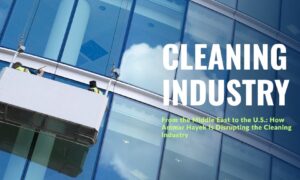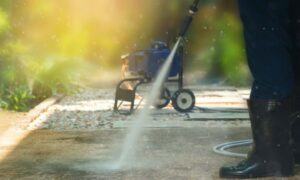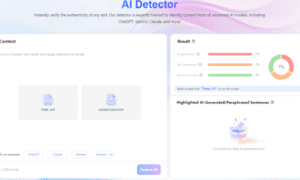The exterior cleaning industry in the UK has experienced significant technological advancements in recent years. These developments have not only improved the effectiveness of cleaning techniques but have also enhanced safety and efficiency for professionals. From gutter vacuums to soft washing, and the increasing use of high-tech systems like water-fed poles and steam cleaning for roofs, the industry is constantly evolving. This article will explore these technological advancements, focusing on the tools and systems that have reshaped how exterior cleaning services operate.
Gutter Vacuums and How They Work
Gutter cleaning is a vital service for maintaining the structural integrity of a building, yet it’s often a dangerous and messy job. Gutter vacuums have revolutionised this aspect of exterior cleaning, offering a safer and more efficient alternative to traditional methods. These vacuum systems use high-powered suction to remove debris from gutters, all without the need for ladders or scaffolding.
The vacuum itself typically consists of a large, powerful motor that is connected to a long, flexible hose. The operator controls the system from the ground, using the hose to insert into the gutter and vacuum out leaves, moss, and other debris. Many of these gutter vacuums come with additional features, such as a high-definition camera mounted on the hose, allowing workers to see inside the gutter and ensure a thorough clean.
By eliminating the need for ladders, gutter vacuums significantly reduce the risk of accidents and injuries. They also improve efficiency, enabling cleaning to be done much faster than with traditional manual methods. Furthermore, gutter vacuums help maintain the safety of both the operator and the property.
A study conducted by the Health and Safety Executive (HSE) found that working at height continues to be one of the most common causes of workplace injuries in the UK, accounting for 40% of fatal injuries in the construction industry. By utilising gutter vacuums, exterior cleaning businesses can reduce the risk of such accidents, ensuring a safer working environment for their employees.
Chemical Application in Soft Washing: The X Jet System
The soft washing technique has emerged as a game-changer in the exterior cleaning industry, especially when it comes to delicate surfaces like roofs, render, and external walls. Unlike traditional pressure washing, soft washing uses low pressure combined with specialized cleaning chemicals to remove dirt, algae, and other contaminants. This method is safer for the surface being cleaned and is more effective at eliminating organic growth such as moss and lichen.
Modern exterior cleaning technologies have revolutionized how properties are maintained, combining environmental consciousness with powerful results. Companies like Clean Society are implementing these innovations to reduce water consumption while delivering superior cleaning performance, demonstrating how cutting-edge tools continue transforming this essential service industry.
A critical component in the soft washing process is the X Jet system. The X Jet is a device used to apply cleaning chemicals at low pressure, helping to ensure that the chemicals penetrate the surface and work efficiently without damaging it. The X Jet system is designed to allow the operator to apply chemicals from a safe distance, using a long extension lance. This means that workers no longer need to be in close proximity to hazardous chemicals, improving both safety and efficiency.
The versatility of the X Jet system has made it popular in the cleaning of roofs, building facades, and other delicate surfaces, allowing for precise chemical application. The system is often used in combination with surfactants and biocides, which help break down dirt and kill any organic growth, ensuring long-lasting results.
Research by the Pressure Washing Institute (PWI) highlights that soft washing is not only safer for surfaces but also provides better long-term results when compared to high-pressure washing. The institute found that soft washing could remove up to 99% of organic growth on surfaces, such as roofs and walls, compared to high-pressure cleaning, which can damage surfaces and may only remove 75% of organic matter.
Waterfed Pole Window Cleaning Systems
Waterfed pole systems have been a staple in the window cleaning industry for some time, but recent innovations have significantly improved their performance. These systems now include the ability to pump cleaning chemicals through the poles, making them even more versatile.
One such development is the Xline chemical trolley system. The Xline system allows operators to apply cleaning chemicals through their waterfed poles, greatly expanding the system’s capabilities. This trolley is remote-operated, meaning the operator can control the flow of chemicals from a distance, ensuring precise application. The trolley is also designed to handle harsh chemicals, meaning it can withstand the corrosive properties of certain cleaning agents used for more stubborn stains.
This advancement has brought about several benefits, particularly in the safe cleaning of windows at height. Waterfed poles with chemical integration enable window cleaners to reach higher levels without the need for ladders or scaffolding, reducing the risk of falls. The system’s ability to purify water also ensures that no streaks are left behind, creating a sparkling finish on windows.
Research conducted by the British Window Cleaning Academy (BWCA) found that waterfed pole systems have reduced workplace injuries by over 60% in the window cleaning industry, with fewer workers needing to climb ladders or scaffolding. The added capability to pump chemicals through the poles further enhances the system’s efficiency, making it ideal for both residential and commercial properties.
Traditional to Reach and Wash Window Cleaning: A Safety Revolution
The move from traditional window cleaning methods to reach and wash systems has transformed the industry in terms of safety and efficiency. Traditional methods involved using ladders, squeegees, and cloths, often requiring workers to climb to dangerous heights. In contrast, the reach and wash system, powered by waterfed poles, allows professionals to clean windows up to several storeys high from the safety of the ground.
Fife Window Cleaning Services found that this shift has not only improved safety but also led to faster cleaning times. Workers no longer need to manually climb ladders or scaffolding, significantly reducing the likelihood of accidents. Furthermore, because the water used in the system is purified, it ensures a streak-free finish without the need for detergents or chemicals that can leave residue behind.
In addition to safety, the reach and wash system is also eco-friendly. By using purified water instead of chemical cleaners, the system reduces the environmental impact of window cleaning. This aligns with growing demand for sustainable cleaning solutions, making it an attractive option for both cleaning businesses and customers who prioritise eco-friendly practices.
Roof Cleaning: Steam Cleaning Systems for a Safer, More Effective Clean
Roof cleaning is another area of the exterior cleaning industry that has seen significant advances in technology. Traditionally, roof cleaning involved scraping or pressure washing, which could cause damage to roofing materials. However, newer methods, such as low-pressure steam cleaning, have emerged as a safer and more effective alternative.
Steam machines, like those made by Mazonni, are specifically designed for roof cleaning. These systems use low-pressure steam to safely remove moss, algae, and other debris from the surface of a roof. The steam gently lifts the contaminants without causing damage to the roof’s tiles or slates. In the past, high-pressure water was often used, which could dislodge tiles or cause leaks. Steam cleaning eliminates this risk by applying gentle pressure, making it a safer and more effective method for roof cleaning.
These steam systems can be used from scaffolding, allowing cleaners to reach difficult areas of the roof without the need for harsh physical scraping. The Mazonni steam machines are highly regarded for their ability to clean even the most delicate roofs while preserving their integrity. Moreover, they help prevent the growth of moss and algae in the future, keeping roofs clean for longer periods.
Research by the Roofing Industry Alliance (RIA) suggests that low-pressure steam cleaning extends the lifespan of roof materials, as it is less likely to cause damage compared to high-pressure water cleaning. This method also prevents the buildup of algae and moss, which can deteriorate roofing materials over time, ultimately saving property owners on costly repairs.
The Evolution of the Exterior Cleaning Industry
Technological advancements in the exterior cleaning industry have significantly improved the safety, efficiency, and effectiveness of cleaning methods. Gutter vacuums, soft washing with the X Jet, and the integration of chemical application in waterfed poles have revolutionised the way exterior cleaning is performed. At the same time, the shift to reach and wash systems and the use of steam cleaning for roofs have enhanced safety, reduced environmental impact, and improved overall results. These developments reflect the industry’s ongoing commitment to innovation and to providing safer, more sustainable services for customers across the UK.

































